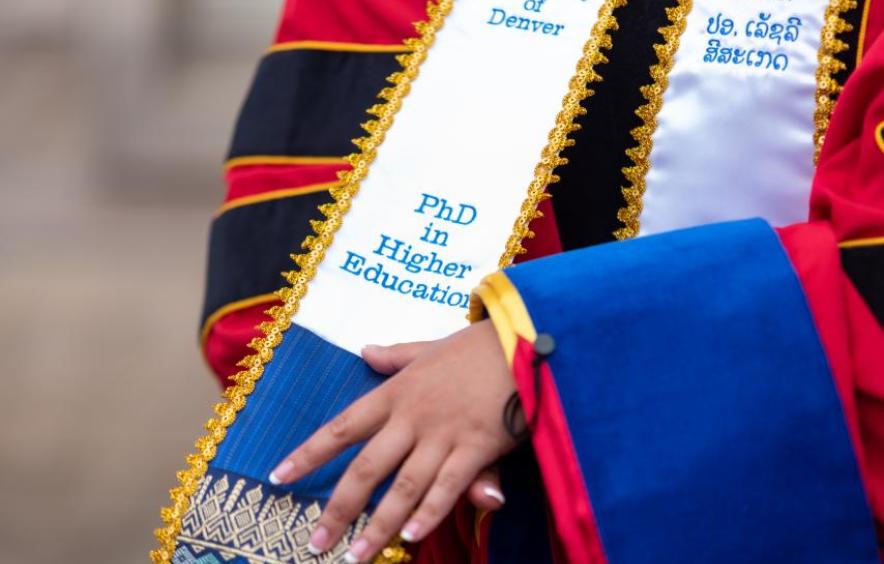2024 MCE Doctoral Hooding Ceremonies
The Summer Hooding Ceremony for doctoral graduates of the Morgridge College of Education is underway! Please check back regularly for updated event information.
On This Page

Ceremony Dates and Times
Summer 2024
The Hooding Ceremonies for Summer 2024 graduates will be held August 23, 2024, at Anderson Academic Commons.
Schedule
- 9:00 am – 11:30 am (MT): Anderson Academic Commons, Room 290 (Gregg Kvistad Special Events Room)
- 11:30 am – 1:00 pm (MT): Graduate Reception, Katherine A. Ruffatto Hall, Commons
Resources
-
Program
Order of Events
9:00 am - 11:30 am (MT), August 23, 2024
- Processional of Faculty
- Processional of Doctoral Candidates
- Land Acknowledgement
- Welcome and Opening Remarks
- Dr. Michelle Knight-Manuel, Dean
- Hooding of Candidates
- Closing Remark
- Dr. Maria Salazar, Associate Dean, Faculty Affairs & Diversity, Equity, Inclusion & Justice
- Recessional of Faculty and Doctoral Candidates
-
Livestream
Watch the livestream here.

Graduate FAQs (What to Expect)
Please visit the DU Commencement portal for additional FAQs, including details on registering for graduation and ordering regalia.
-
Where, When, What Time?
This ceremony will be held Friday, August 23 at Anderson Academic Commons. Please arrive in full regalia at 8:15 a.m. Please line up in your section designated by signs on the walls. Programs will be provided with the line-up order and volunteers will be present to assist. Students will process into reserved seating in the first few rows.
-
Program & Procedure of the Ceremony
The program will include a welcome from Dean Knight-Manuel, hooding of the doctoral graduates, and closing remarks from Associate Dean Dr. Maria Salazar. Department Chairs will speak briefly about each department.. Following the order in the program, faculty will approach the podium, introduce the graduate, and read the title of the student’s dissertation or dissertation in practice.
-
Hooding
Hold your hood by the string and hand it to the faculty. Ensure the center string is buttoned before you enter the stage. Bend at your knees so that the faculty may place the hood over your head.
Once your hood has been placed, the faculty will step to the right of the podium so that you may step forward and share your remarks.
As a reminder, graduates have been given the option to prepare remarks up to 2 minutes maximum to include acknowledgements and one to two of their most significant insights from their doctoral research. We have found that students are most successful when they bring their remarks in writing to ensure they do not forget anyone in their acknowledgements. We also recommend running your script by your advisor to ensure it is succinct and effectively conveys your message.There will be someone timing you and will indicate when your time is up. Please adhere to this time limit so that all graduates have the opportunity to share remarks. Once your remarks are complete, please return to your seat.
-
Ceremony Closing & Reception
The ceremony will end with closing remarks, and all are invited to the MCE Graduation Reception immediately following the ceremony in Katherine Ruffatto Hall Commons.
-
Livestream
The ceremony will be live streamed on the MCE YouTube channel. Please feel free to share the link with family and friends who are unable to join in person.
-
DU Commencement Policies and Guidelines
Find more on policies and guidelines here.

Graduation Regalia
Online ordering through the DU Bookstore is available for all students. Please visit DU Commencement for information on ordering your regalia.
-
Gowns & Robes
The academic gown is usually black and is worn at all levels of education. It is to be worn closed and zipped. The robe is often ankle- or mid-calf length. The Bachelor’s gown is the most simple; the Master’s gown typically has longer, oblong sleeves; and the Doctoral gown is more elaborate, made of velvet, and has three stripes on the bell-shaped sleeves that indicate the school/area of study.
-
Hoods
Hoods are conferred upon students when they graduate with a Master’s or Doctoral degree. They are made of the same material as the gown. The hood is3.5′ long (Master’s) or 4′ (Doctoral) and features a velvet trim that indicates the discipline of graduation. The lining of the hood indicates the colors of the college from where the student graduated.
-
Caps, Mortarboards & Tams
Caps and mortarboards also become more elaborate with more degrees. Bachelor’s and Master’s graduates have a flat cap with a tassel. The tassel starts on the right and graduates move it to the left once they receive their diploma (a good way to remember this is that they “left” their institution). A doctoral cap is known as a “tam” which is velvet; has four, six, or eight corners; and is floppier than the traditional cap.
-
Colors
The colors of hoods symbolize the department/discipline of graduation. Here are some common ones you might see:
- Light blue – education, counseling
- Citron (yellow) – social work
- Dark blue – all Ph.D.
- Purple – law
- White – history, sociology
- Gold – psychology
- Crimson (dark red) – communication
- Lemon – library science
-
Accessories
Graduates might wear other items with their graduation regalia, such as stoles, cords, medals, and medallions.
- Academic stoles, which look like thinner, satin hoods, are decorative in nature and typically indicate membership in clubs and organizations.
- Cords, or braided rope, are often worn to show academic achievement (e.g. summa cum laude).
- Medals and medallions are bestowed upon faculty or students for important titles or positions (e.g. Chancellor, President, Valedictorian).
-
History
The history of the academic regalia we see today dates back to the 12th and 13th centuries when colleges and universities in western Europe were first being founded. It was the traditional dress of the clergy and monks at the time who often conducted business in cold, unheated churches. Gowns were worn to keep warm and hoods, or skull caps, were used to cover shaved heads. Caps and gowns were seen as markers of privilege and distinguishment. The colors that we see today were implemented and standardized in the late 19th century in order to bring more uniformity to the ceremony following an increase in the number of college students.